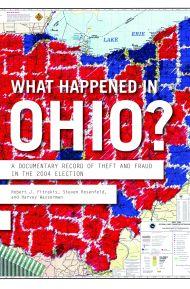by Bob Fitrakis & Harvey Wasserman
April 5, 2007
In a victory for election protection activists, Ohio’s powerful GOP Chair Bob Bennett will be forced to face a public hearing on his removal as Chair of the Cuyahoga (Cleveland) Board of Elections. And in a second triumph, Ohio Secretary of State Jennifer Brunner has agreed, as part of a legal settlement, to take possession of the ballots and other key documents from the disputed 2004 election that gave George W. Bush a second term in the White House.
Brunner has requested the resignations of the entire scandal-plagued Cuyahoga County Board of Elections, which Bennett has chaired. Two Democratic members and one Republican have complied with her request. The BOE’s executive director, Michael Vu, previously resigned amidst a cloud of scandal resulting from a mishandled primary election and more than $12 million in budgetary overruns. Two BOE workers have been given 18-month prison sentences for felony convictions stemming from what a government prosecutor called the “rigging” of an officially mandated recount for the 2004 presidential election.
Bennett has issued a legal challenge against his removal. But on Wednesday, April 4, Franklin County Common Pleas Judge John Connor ruled Bennett has to comply with Brunner’s call for a public hearing on the matter. The hearing is scheduled for Monday, April 9.
A long-time GOP power broker, Bennett is a close personal confidante of White House advisor Karl Rove. He has been Rove’s point man in Ohio’s most populous county, which includes the Democratic voter rich city of Cleveland. A wide array of irregularities there were pivotal in giving Bush his narrow margin of official victory in 2004.
Bennett asked the court to rule that the Ohio statute seeking his removal was unconstitutionally vague. But Judge Connor ruled that the law was “clear and unequivocal.”
This is Bennett’s third major setback in three days. On Monday, April 2, Brunner put the Cuyahoga BOE under state administrative oversight because it lacked a quorum to conduct business. With the resignations of the other three board members, Bennett stood alone as the sole board member.
On Tuesday, April 3, Brunner suspended Bennett, citing the fact that as BOE chair he had allegedly “instructed” former Executive Director Vu to award a contract to a consultant without Board approval.
“Bennett instructed Vu to award a second contract to David Hopcraft in the amount of $14,750 on or about February 26, 2007, for public relations services to be paid for by public dollars by the Board of Elections,” Brunner wrote in her suspension statement.
The statement adds that: “The Dayton Daily News on March 26, 2007 reported Mr. Hopcraft to be a ‘GOP spokesperson.’ According to Board policy, no contract for services may be awarded without Board approval if it exceeds $15,000. The extension of Hopcraft’s contract for just under $15,000, without Board approval, violates Board policy,” Brunner’s statement says.
Brunner’s order suspends all of Bennett’s powers. It orders Bennett not to attend any Cuyahoga County BOE meetings or to be present at the BOE offices. The suspension is indefinite, pending the results of the removal hearing and any subsequent legal appeals.
On March 21, Bennett lashed out following the convictions of two Cuyahoga County BOE workers charged with “rigging” the 2004 presidential recount. Bennett said, in part: “… the public deserves to know that the big shots, the lawyers and the special political interests are not going to grind up the people who are doing the public’s work at this Board.”
Steve Hertzberg of the nonprofit Election Science Institute, which conducted an investigation of major problems that marred the 2006 Cuyahoga County primary election, responded to Bennett’s attack by stating, “It is an insult to the intelligence of the Cuyahoga community that Mr. Bennett attempts to lay blame elsewhere while he attempts to maintain his lucrative position on the CCBOE. Not only should this man resign immediately, he should apologize for the myriad of mistakes and the damage he had done to the reputation of Ohio and its citizens.
“Shame on you, Mr. Bennett,” Hertzberg concluded.
In another decisive action, which may stand as a major landmark, Brunner has agreed to take responsibility for the preservation of the ballots from Ohio’s 2004 presidential election.
The ballots were subject to destruction in early September 2006, as the law protecting them was about to expire. However, a suit involving the King-LincolnBronzeville Neighborhood Association, among others, was filed in federal court. The suit alleges a wide range of civil rights violations against inner city and other Ohio voters in the conduct of the 2004 Ohio election. It also asked that then-Secretary of State J. Kenneth Blackwell be prevented from ordering the disposal of the ballots and other election materials, which he was poised to do.
The suit gained widespread national attention, including news stories and editorial comment in the New York Times. On September 11, 2006, Federal Judge Algernon Marbley issued an order preserving the ballots pending the outcome of what has become known as the King-Lincoln lawsuit.
Blackwell left the office of Secretary of State earlier this year, in the wake of his unsuccessful run as the GOP’s 2006 nominee for Governor of Ohio. By and large, the materials have been stored by Ohio’s 88 counties.
As the new Secretary of State, Brunner has now agreed to a joint motion as defendant in the King-Lincoln suit. The motion effectively transfers the custody of “…all ballots from the 2004 presidential election, on paper or in any other format, including electronic data,…” from the counties to Ohio Secretary of State’s office.
Ohio Attorney General Marc Dann’s office is representing Brunner.
In a Memorandum in Support of the Joint Motion, the parties state: “To lessen the burden on the respective boards of elections and to provide a central repository for records, the parties are jointly requesting that an order be entered in this matter requiring the 88 county boards of elections to transfer to the custody of the Secretary of State all ballots from the 2004 presidential election….”
Voting rights activists have urged the state to preserve all the records and open them to interested parties following the Florida 2000 election model, which created a centralized accessible repository following the controversial 2000 election in the Sunshine State.
Brunner is now widely expected to do the same for the documents that defined the disputed presidential election of 2004. Scrutinized over the coming years, they could finally reveal what really put George W. Bush back in the White House for a second term.
They may also illuminate Bob Bennett’s role in making that happen.
Original post at:
https://freepress.org/departments/display/19/2007/2525
—
Bob Fitrakis is one of the attorneys representing the King Lincoln Bronzeville Association and Harvey Wasserman is one of the plaintiffs. They are co-authors of HOW THE GOP STOLE AMERICA’S 2004 ELECTION & IS RIGGING 2008 (www.freepress.org) and WHAT HAPPENED IN OHIO? from the New Press. Photo by Adele Eisner.

 As the third of four members of the Cuyahoga (Cleveland) County Board of Elections resigns under pressure from Ohio’s new Secretary of State, additional potential illegalities in Hocking County have resurfaced with new weight against a GOP executive director already under serious fire.
As the third of four members of the Cuyahoga (Cleveland) County Board of Elections resigns under pressure from Ohio’s new Secretary of State, additional potential illegalities in Hocking County have resurfaced with new weight against a GOP executive director already under serious fire.
 I haven’t blogged since the election, although there have been a few postings of articles I’ve written for the Free Press. But I break this unofficial vow of silence to mourn Molly Ivins, the longtime Free Press columnist and Pulitzer Prize-nominated writer.
I haven’t blogged since the election, although there have been a few postings of articles I’ve written for the Free Press. But I break this unofficial vow of silence to mourn Molly Ivins, the longtime Free Press columnist and Pulitzer Prize-nominated writer.